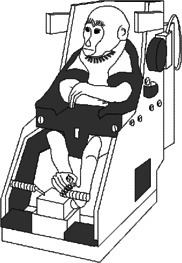Mission type Bioscience SATCAT no. 14549 | COSPAR ID 1983-121A Mission duration 5 days Launch date 14 December 1983 | |
 | ||
Operator Institute of Biomedical Problems / NASA Similar Kosmos 1129, Kosmos 1667, Kosmos 936, TDRS‑1, INSAT‑1B | ||
Bion 6 or Kosmos 1514 (in Russian: Бион 6, Космос 1514) was a biomedical spaceflight research mission that was launched on December 12, 1983. It was part of the Bion satellite program.
Contents
Mission
Two Rhesus monkeys were flown into orbit implanted with sensors to permit monitoring of carotid artery blood flow. Eighteen pregnant white rats were used for studies of the effects of microgravity and radiation. The rats subsequently produced normal litters. The mission ended after five days.
This was the first time the Soviet space agency flew monkeys in Space, coming 34 years after the U.S. first put a monkey into space (and 22 years after the Soviet Union started putting humans into space).
The mission differed markedly from earlier Cosmos flights, both in terms of Soviet scientific goals and in the degree of cooperation required between the United States and the USSR. The two countries had to interact at a high level because much of the U.S. experiment hardware had to be integrated with the Soviet spacecraft and instrumentation systems.
Experiments focused on the effect of weightlessness on various physiological parameters. A study of circadian rhythms was concerned with the synchronization of primate motor activity, body temperature and skin temperature rhythms to a fixed light/dark cycle and to each other. Blood pressure and flow were monitored, to evaluate short and long-term changes in these parameters. Changes in calcium metabolism were studied in order to determine the effect of weightlessness on the skeleton. The two rhesus monkeys (Macaca mulatta) flown onboard were about three years of age and each weighed approximately 4 kilograms. Height was a constraint in selecting animals for flight. This was because a Soviet vestibular experiment required that the flight restraint couches oscillate vertically within the animal capsules. The monkeys were conditioned to sit in the restraint couches and perform tasks for food rewards.
Tasks included pressing a lever with their feet and tracking a moving light with their eyes. Monkeys were also trained to eat and drink from food and juice dispensers. Monkeys in the flight and control groups were implanted with blood pressure and flow cuffs and sensors to measure several physiological parameters. A neuroontogeny experiment was conducted to investigate space flight effects on the sensory development of rats that spent part of their prenatal gestation period in space. Ten pregnant female Wistar rats (Rattus norvegicus) were flown. Ground control groups contained the same number of rats. At the start of the flight or control experiments, the rats were at gestation day 13 of their 21-day cycle.
